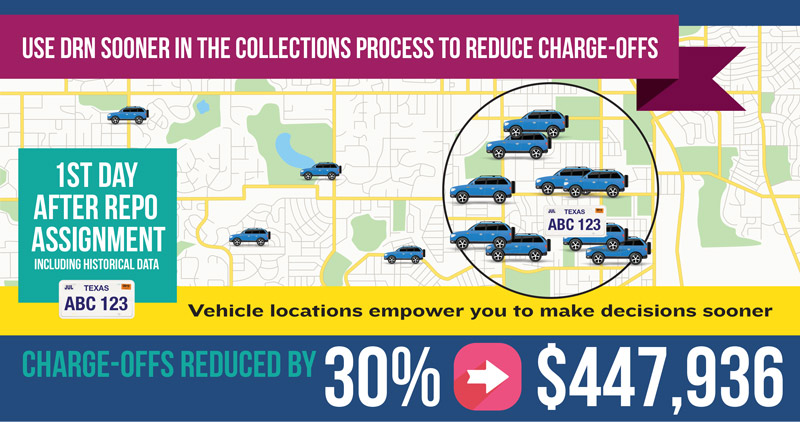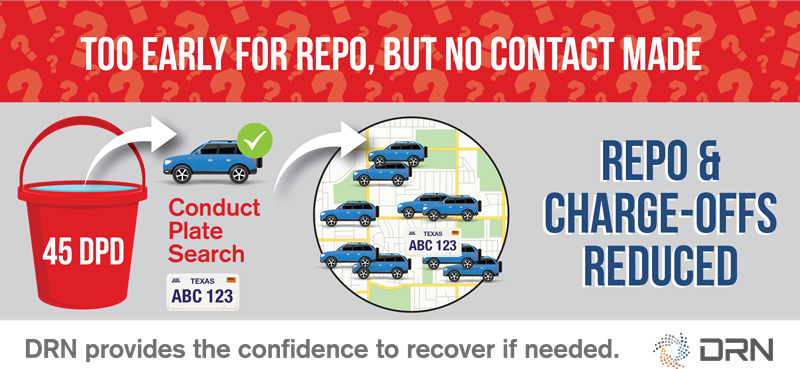Days past due (DPD) strategy often leads to repo or charge-off: use vehicle location data as the trigger to avert losses.
At our lender round-up in February, we heard from 20 of the top auto lenders in the nation. The main takeaway? “All of the lenders are being challenged to be more competitive.” These lenders are buying deeper and lending more with longer loan terms, and as a result, they are experiencing more repossessions and charge-offs. Just a short time after our event, Fitch Ratings reported the rate of seriously delinquent subprime car loans had climbed to 5% in February – the highest level since 1996. The Fitch report echoed the lender’s sentiment and served as a call to action: time to curb charge-offs, increase recoveries and improve collections outcomes.
Lenders spoke and we listened. We challenged a prime and near-prime lender to rethink their collections and recovery strategy that relied on days past due (DPD) formulas and put our vehicle location data to the test. And the results just might surprise you.
Prime Auto Lender: Seeing $447,936 Monthly Charge-Off Reduction is Believing
Goal: While some auto lenders we spoke with continued to focus on recoveries, this prime lender honed in on avoiding charge-offs. Their goal was to recover debt earlier to put the brakes on skip charge-offs.
Before: They were already using DRN’s data through RDN to recover vehicles. Their old process was to apply DRN’s vehicle location data at 15 days after repossession assignment for live pick-up. While this strategy delivered recoveries, many were too late to avoid skip charge-offs.
After: They applied DRN’s vehicle location data at day one of repossession assignment. This enabled them to leverage DRN’s 4.2 billion historical sightings to locate their vehicles faster, thereby avoiding skip charge-offs.
Results: Reduced the number of accounts that rolled to charge-off or skip by 30%, saving this lender $447,936 in skip charge-off losses each month.

How does this work?
For this lender, operationalizing DRN’s vehicle location data and insights to reduce skip charge-offs was easy. Since they were already using DRN’s data through RDN, we flipped a switch in RDN and sent vehicle location data on ALL repossession orders instead of waiting for 15 days after repo. This new model delivered on the promise of reduced skip charge-offs.
Regional Near-Prime Lender Reduces Charge-Offs, Cures More Loans, Nets 188% ROI
This regional near-prime lender’s stated goal was to mitigate risk by reducing charge-offs. The reality is that for some lenders like this one, the larger risk pools they created to remain competitive have also led to more charge-offs. Even though as a percentage, the rate of charge-offs remains steady, the larger debt pools add up to a higher volume of debt charged-off. Couple that with the fact that lenders are seeing less money from cars at auction due to the auction glut, and you’ve got increased pressure across the severity side of the business.
This near-prime lender told us that while reducing charge-offs remains a focus of their efforts, they also wanted to strategically use vehicle location data to cure loans. A one-two punch approach netted a reduction in charge-off losses and a competitive strategy for curing loans previously deemed “uncurable.”
Near Prime Lender: New Strategies for Applying Vehicle Location Data
Goal 1: A challenge to avoid repossessions altogether knowing that once you roll into repo, you are looking at higher losses even if you don’t go to charge-off.
Before: The lender was already using DRN’s vehicle location data through RDN for recovery, but they were not using the data on accounts with no contact at 45 days past due because these did not hit the repo threshold.
After: They applied DRN’s vehicle location data earlier than the 45 DPD to avoid repossession altogether. For these high-risk accounts that fell into that bucket of “too early for repo but no contact made,” they used DRN’s data to help them make right party contact.
Results: Using the data prior to sending out for repossession gave this lender the ability to make contact in many instances. They were able to offer loan workouts, secure promises to pay, and even cure some loans by using the data to help make right party contact. Plus, once they used the data to make contact, they had the confidence that IF and when they needed to get the car, they could. This confidence in being able to recover the vehicle at any time if need be, gave the lender options to work out and cure loans that previously would have ended up in repossession for a loss on the books.

Goal 2: Knowing that it is inevitable for some loans to go to repossession, this lender wanted to mitigate risk as much as possible and reduce the number of loans that ended up a charge-off loss.
Before: While they used DRN’s data through RDN, this lender did not use any of the historical data.
After: Now, they use the historical data on day one of repossession. Since they were already using the data through RDN, it was as simple as turning the historical data “on” earlier.
Results: Using historical data enabled them to identify location clusters for faster recovery. They averted 12 charge-offs in a one-month period for a total of $216,000 in savings. This lender saw a 188% ROI as a result of the charge-off savings.
Lesson Learned
DRN listened to the lenders and understood their need to get more data faster. We have created a model that allows lenders full access to live and historical data for a flat rate. DRN’s historical data including over 4.2 billion nationwide vehicle sightings became a strategic difference for these lenders. And using the data as the trigger for action, versus days past due, resulted in a reduction in charge-off losses, and even gave them a way to avoid losses by making contact to help cure loans.